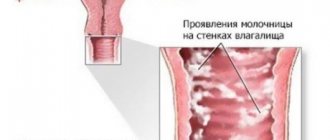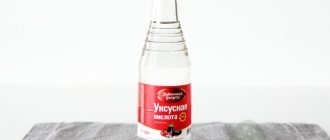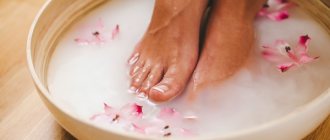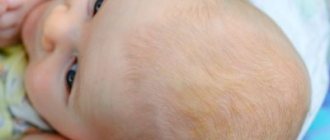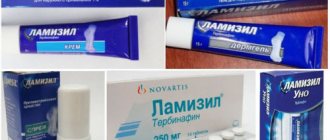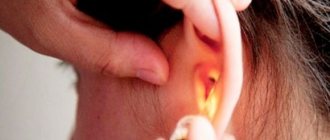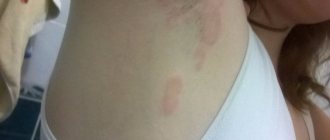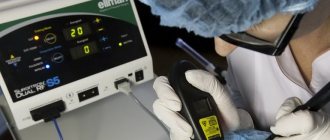Types of fungus in children
Fungus on the hands, feet and other parts of the body in children is caused by pathogenic microflora. All pathogens of this infection are divided into several separate groups, each of which is characterized by its own characteristics of life.
There are such types of fungus that a child of any age can become infected with:
- Candidiasis. The pathogen develops active life activity on the mucous membranes. Most often, infants suffer from it;
- Trichophytosis. Diagnosed when fungus is detected on the skin, nails and mucous membranes on different parts of the body;
- Cryptococcosis. The causative agent of infection affects internal organs;
- Aspergillosis. The pathogen penetrates the lungs and infects their tissues.
There is another classification of mycoses in children according to localization. In this case, the fungus can be systemic, that is, affecting internal organs, and superficial, which is characterized by spreading to the skin.
Infants are often diagnosed with mucosal yeast
Damage to feet and nails
Foot fungus is caused by contact with contaminated surfaces in bathrooms, swimming pools or kindergartens. There are four forms of the disease:
- The interdigital lesion forms cracks and peeling with a white tint. This variety is most common among young children.
- The plantar form is manifested by scaly spots in the form of a circle or plate, associated with thickening of the nails, whitening and yellowing. Children complain of itchy feet.
- Vesicular or associated with the appearance of blisters filled with fluid. Most often, the rash affects the arches of the feet and the base of the toes. The disease can become chronic and affect large areas.
- The erased form of the fungus is associated with the appearance of white scales and cracks between the fingers.
In almost 90% of cases, the source of infection is Trichophyton rubrum or Trichophyton mentagrophytes, and in 2-9% - yeast fungi.
Reasons for appearance
Fungal diseases of the skin and nails in children occur for various reasons. Their pathogens surround humans almost everywhere. They are highly resistant to many aggressive factors. They are not particularly afraid of low and high temperatures, sunlight and drying processes.
Fungal pathologies in childhood occur in the form of isolated cases. They can become epidemic in nature, affecting a large number of people who are in the same group.
People and animals can be carriers of the fungus. Infection of a child with this disease occurs at the moment of direct contact with the carrier of the infectious agent. This also often happens when touching an infected item. Most often, children become infected in the following places:
- Public beach;
- Pool;
- Salon;
- Kindergarten, school;
- Bath;
- Sauna.
Fungus in children on different parts of the body, for example, on the fingers, easily attaches to the child’s skin. The risk of infection for a child is higher than for an adult. This is due to the structural features of their epidermis. The skin of babies is highly susceptible to injury; it is characterized by a low level of bactericidal activity of the gonads and high vascularity.
Among the reasons that lead to the appearance of a fungal infection in a child, doctors also include uncontrolled use of antibiotics by young patients.
Some types of fungus can be contracted from animals
Signs of the disease
Fungus in adults and children has a number of symptoms that distinguish it from allergic and other infectious diseases:
- the appearance of cracks and peeling around them;
- severe itching, redness and soreness of the skin;
- dry areas;
- irritation of interdigital folds;
- peeling of the skin of the feet;
- blistering rash on the feet;
- splitting or discoloration of the nail.
A skin fungus on the body forms diaper rash in the folds of the skin, pink or gray spots on the head, as well as moist round lesions with a red edge.
Ringworm is manifested by pink skin lesions and hair damage that breaks off at different lengths. Microsporia is recognized by large areas of peeling and hair loss. The cause of the disease is contact with an infected person or animal.
Symptoms
Children who are sick with fungus cannot always complain about the symptoms of illness that bother them. Therefore, parents should regularly examine the child for unnatural changes and, if necessary, seek the help of their doctor.
Signs of infection by pathogenic microflora of different species differ from each other. The manifestation of the fungus directly depends on its location and type.
| View | Features |
| On foot | The fungus is usually localized on the toes and feet. Small wounds appear in these places, which gradually turn into ulcers. The skin at the site of the lesion constantly itches and turns red. The child also has difficulty walking, as this process causes him pain. |
| On the nails | The nail plate begins to acquire a gray, then black color. It itself noticeably thickens and peels off. The appearance of inflammation of the skin that is located next to the infected area cannot be ruled out. |
| Ringworm | The fungus is active on the scalp and hair. They begin to fall out little by little or break off greatly. The skin in the affected area turns red and peels. The child is also bothered by itching. When scratching infected areas, wounds are formed into which pathogenic bacteria can penetrate. In this case, high temperature will also join the general symptoms. |
| Pityriasis versicolor | Most often, this type of fungus is noticed on the skin of the back. It is recognized by characteristic yellowish or white spots that may peel off. There is usually no itching. |
| Candidiasis | Yeast most often affects the intimate area or oral cavity of a child. A white coating with a cheesy consistency appears in the affected areas. If you erase it, small wounds and ulcers will appear on the mucous membrane. Sometimes with this form of fungal infection in children, the body temperature rises to 37.5. |
Based on the symptoms of the pathological process, you can first recognize the type of fungal infection from which the baby is suffering.
Symptoms vary depending on the type of fungus and location
Signs of the disease
Fungus in adults and children has a number of symptoms that distinguish it from allergic and other infectious diseases:
- the appearance of cracks and peeling around them;
- severe itching, redness and soreness of the skin;
- dry areas;
- irritation of interdigital folds;
- peeling of the skin of the feet;
- blistering rash on the feet;
- splitting or discoloration of the nail.
A skin fungus on the body forms diaper rash in the folds of the skin, pink or gray spots on the head, as well as moist round lesions with a red edge.
Ringworm is manifested by pink skin lesions and hair damage that breaks off at different lengths. Microsporia is recognized by large areas of peeling and hair loss. The cause of the disease is contact with an infected person or animal.
Diagnostics
Mycosis of the skin and nail fungus in a child are recognized thanks to special diagnostic methods. These diseases are usually treated by a mycologist. It is to him that the pediatrician will refer the young patient.
The following methods of examining the patient allow the diagnosis of fungus on the legs of a child or on any other part of his body:
- Examination of skin or nail plates that have been affected by infection. The doctor should not only visually inspect the areas, but also check them under a Wood's lamp;
- Microscopy. To carry out this diagnosis, it is necessary to take material that has been affected by the fungus. It consists of hair, keratinized layers of the nail, and skin scales. The study is carried out under a microscope, which allows the specialist to see the presence of pathogenic microflora in the tissue sample;
- Sowing the scrapings. It is carried out on a universal or selective environment. This diagnostic method allows you to determine the sensitivity of mushrooms to certain drugs, as well as identify its species.
If a fungus is suspected, a differential diagnosis of this infection with psoriasis, dermatitis, vitiligo and other similar diseases is required.
Diet
Proper nutrition during treatment is the basis for a quick recovery . There are products that promote the growth of fungal spores, creating a breeding ground for them. During illness, you should not give your child the following foods:
- any sweets and baked goods;
- yoghurts containing dyes and fruit additives;
- cheeses;
- milk;
- white bread, pasta.
The basis of the diet should be:
- potatoes and fresh vegetables;
- natural yogurt without sugar;
- fermented milk products, cottage cheese;
- apples, lemon, cranberries, black currants;
- green and black tea without sugar;
- eggs.
ADVICE. Olive oil and garlic prevent the development of fungal spores in the intestines. Nutritionists advise adding these components to fresh vegetable salads.
How to treat fungus
Treatment of fungus in children requires an individual approach. The specialist must select the most safe medications for health. In this case, you need to pay attention to their effectiveness in the fight against mycosis.
If necessary, the doctor will recommend hospitalization for the child. This measure is usually required if the baby has concomitant problems that complicate the course of the fungal infection.
Drug treatment
Fungus of the nails on the hands and feet, as well as mycosis of the skin in children, is treated with medications. Complex or monotherapy is selected for the baby. In the first case, it consists of different groups of medications:
- Antihistamines;
- Immunostimulants;
- Vitamin complexes;
- Hormonal drugs;
- Antifungal agents of local and systemic action.
During treatment, it is recommended to use tablets and ointments to increase the effectiveness of the therapeutic course. For children with an infection, for example, the little finger or the oral mucosa, the following medications are suitable:
- "Miconazole";
- "Limisil";
- "Exoderil";
- "Clotrimazole".
Antifungal ointments are recommended to be applied to the skin and nail plates about 2-3 times a day. It is best to treat the infected areas with topical medications in the mornings and evenings. This course of treatment is usually followed for 1.5 months.
If nail fungus in children continues to progress, then treatment is supplemented with tablets. They fight pathogenic microflora from inside the body.
Systemic therapy for fungus in children is usually carried out using the following means:
- "Diflucan";
- "Griseofulvin";
- "Terbinafine".
Ointments containing zinc, tar or salicylic acid also help in the fight against lichen in a child. In particularly severe situations, the use of hormonal drugs is required.
Yeast fungus in children that is found in an intimate place is recommended to be treated with Mycelex and Monistat suppositories.
It is prohibited to independently treat mycosis in a child.
Folk remedies
Not only traditional, but also traditional medicine helps cure a nail or skin from mycosis. The methods she proposed are safe for the child. Fungus of the nail, mucous membrane or skin can be treated with the following means:
- Celandine. 20 g of plant material should be poured into 1 liter of hot water. When the composition is infused, it needs to be warmed up a little, and then the limbs affected by the fungus are dipped into the infusion. If the infection has affected other parts of the body, they should be wiped with a cotton pad soaked in this product;
- Natural honey. Helps with mycosis of the skin in children. The product in an amount of 1 liter must be mixed with 10 liters of water. This solution is recommended for use for preparing lotions;
- Phytotherapy. A good result can be achieved if you use sage, oak bark, St. John's wort and chamomile in the fight against fungus. Herbs must be used separately. Medicinal infusions are prepared from them, which are suitable for lotions and baths. To make the medicine, just pour 20 g of herb into 200 ml of boiling water and leave for 15 minutes;
- Sea salt. It is recommended to steam limbs affected by the fungus in a solution based on it. To prepare the medicinal composition, only 4-5 tbsp is required. l. salt;
- Mint. Suitable for treating feet infected with fungus. 50 g of fresh mint leaves should be poured into 2 identical bags. Afterwards you need to put them on your feet and secure them with socks. It is recommended to wear peculiar compresses for 2 hours;
- Tea tree oil. You need to moisten cotton pads in it and use them to treat infected areas of the child’s body.
All questions regarding the use of folk remedies in the treatment of a child must be discussed with the attending physician.
Diet
Toenail fungus in children, as well as on other parts of the body, can be overcome with a special diet. It is part of the treatment course. When compiling a child’s diet, it is recommended to include vegetables, fruits, seeds, chicken eggs and dairy products in his menu. Your baby can drink unsweetened tea.
Heavy and unhealthy food will only harm your child. Therefore, it is advisable to abandon it. It is especially important to avoid consuming dairy products, yeast breads and sweets, as they can provide food for pathogenic microorganisms.
The fungus “loves” sweets, so during treatment you need to avoid baking and sweets
Thrush and dysbiosis
Fungal flora dies in an alkaline environment, so the mucous membranes of the mouth are wiped with two types of solutions:
- 2% soda five times a day;
- 1-2% brilliant green 5-6 times a day.
If local remedies do not bring results, the doctor determines how to treat candidiasis. Stomatitis in the first year of life is caused by yeast, which forms a white coating, dries out the mucous membranes and provokes a burning sensation. Children often have a fever, taste preferences change, and appetite decreases.
Fungal stomatitis is typical for children with reduced immunity. Treatment is carried out with antifungal ointments for 7-14 days with rubbing of the mucous membranes with infusions of chamomile and calendula to relieve pain and inflammation.
A competent approach to the treatment of dysbacteriosis in the intestines is to reduce the amount of mycotic flora. Complete destruction of Candida fungi is dangerous because its place in the microbiome will be taken by pathogens - mold or clostridia.
It is advisable to use probiotics only after stabilization of the flora, in which the presence of staphylococcus is reduced. They are not prescribed simultaneously with antimycotic drugs. Treatment must be adjusted after testing for fungus in the intestines.
Please leave a comment:
Please leave a comment:
Fungus in a child is a problem associated with hygiene rules, immaturity of the immune system, and increased vascularization of children's skin. Mycoses are infectious diseases, and babies’ bodies become familiar with them during their first social contacts. Transmission of the pathogen occurs at home, in kindergarten, in a store or on the street. When immunity is weakened due to illness, lack of vitamin D or stress, even non-pathogenic fungi can multiply, becoming the cause of disease.
Features of treatment for children of different ages
In newborns and infants, the fungus usually appears due to contact with its parents, who are already considered carriers of pathogenic microflora. In this case, doctors strongly recommend limiting the use of topical antimycotic drugs when treating the disease. Systemic therapy may be too aggressive for such babies. At the same time, treatment will be required for the person who infected the newborn. You also need to take care to exclude the possibility of relapse of the pathological process in a young child.
Preschoolers in most cases become infected in groups and during visits to various sections. For them, systemic treatment is selected, based on antimycotic drugs such as Griseofulvin and Fluconazole. These drugs have a mild effect on the child’s body, and at the same time they well suppress the main symptoms of the infectious disease.
Treatment of adolescent children has virtually no significant differences from the therapy that is offered to adult patients. The child is prescribed a complex of drugs that destroy pathogenic microflora.
Folk remedies
Treatment of fungus with folk remedies is aimed at relieving unpleasant symptoms. It is impossible to destroy spores with improvised means , so they are used only as auxiliaries along with medications. The following folk remedies have the greatest effectiveness and relative safety:
- decoctions of mint, lemon balm, chamomile, linden;
- infusions based on flax seeds, aloe, oatmeal;
- olive, coconut, sea buckthorn oil to lubricate affected skin.
Memo to parents
The health of a child depends on the actions of his parents. Therefore, adults should monitor their baby more closely and protect him in every possible way from contact with potentially infectious objects and people. Moms and dads should prevent fungal infection for their children. It consists of a number of activities:
- Parents should teach their child to use only their own clothes and shoes in everyday life. Contact with other people's things is usually the cause of infection;
- When visiting a shower, swimming pool or other public place, the baby must wear slippers;
- If the skin or nail is accidentally injured, this area must be treated immediately. For this purpose, a regular antiseptic is used. This will reduce the likelihood of the baby’s wound becoming infected;
- Parents should take care of their child's immune system. It needs constant strengthening. To prevent the child’s body’s defenses from weakening, it is necessary to give the baby foods enriched with vitamins and, if necessary, vitamin complexes.
If there are suspicions that a child has become infected with a fungus, he should immediately be taken to a competent specialist. Self-medication in this situation is strictly prohibited, since inadequate therapy will only lead to a worsening of the baby’s condition.
Damage to feet and nails
Foot fungus is caused by contact with contaminated surfaces in bathrooms, swimming pools or kindergartens. There are four forms of the disease:
- The interdigital lesion forms cracks and peeling with a white tint. This variety is most common among young children.
- The plantar form is manifested by scaly spots in the form of a circle or plate, associated with thickening of the nails, whitening and yellowing. Children complain of itchy feet.
- Vesicular or associated with the appearance of blisters filled with fluid. Most often, the rash affects the arches of the feet and the base of the toes. The disease can become chronic and affect large areas.
- The erased form of the fungus is associated with the appearance of white scales and cracks between the fingers.
In almost 90% of cases, the source of infection is Trichophyton rubrum or Trichophyton mentagrophytes, and in 2-9% - yeast fungi.
